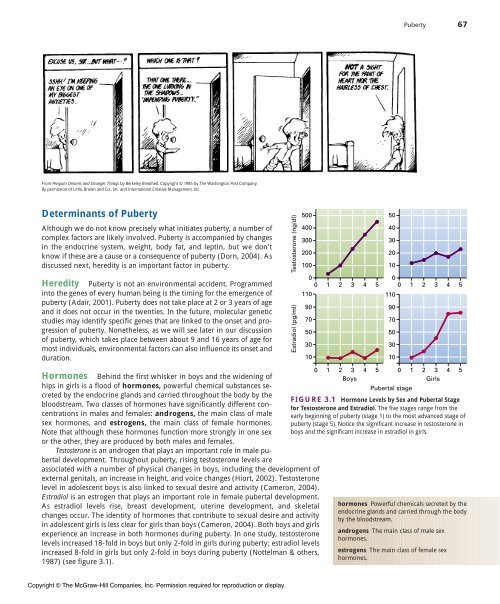Chapter 3 Puberty and Biological Foundations - The McGraw-Hill ...
Chapter 3 Puberty and Biological Foundations - The McGraw-Hill ...
Chapter 3 Puberty and Biological Foundations - The McGraw-Hill ...
Create successful ePaper yourself
Turn your PDF publications into a flip-book with our unique Google optimized e-Paper software.
From Penguin Dreams <strong>and</strong> Stranger Things by Berkeley Breathed. Copyright © 1985 by <strong>The</strong> Washington Post Company.<br />
By permission of Little, Brown <strong>and</strong> Co., Inc. <strong>and</strong> International Creative Management, Inc.<br />
Determinants of <strong>Puberty</strong><br />
Although we do not know precisely what initiates puberty, a number of<br />
complex factors are likely involved. <strong>Puberty</strong> is accompanied by changes<br />
in the endocrine system, weight, body fat, <strong>and</strong> leptin, but we don’t<br />
know if these are a cause or a consequence of puberty (Dorn, 2004). As<br />
discussed next, heredity is an important factor in puberty.<br />
Heredity <strong>Puberty</strong> is not an environmental accident. Programmed<br />
into the genes of every human being is the timing for the emergence of<br />
puberty (Adair, 2001). <strong>Puberty</strong> does not take place at 2 or 3 years of age<br />
<strong>and</strong> it does not occur in the twenties. In the future, molecular genetic<br />
studies may identify specific genes that are linked to the onset <strong>and</strong> progression<br />
of puberty. Nonetheless, as we will see later in our discussion<br />
of puberty, which takes place between about 9 <strong>and</strong> 16 years of age for<br />
most individuals, environmental factors can also influence its onset <strong>and</strong><br />
duration.<br />
Hormones Behind the first whisker in boys <strong>and</strong> the widening of<br />
hips in girls is a flood of hormones, powerful chemical substances secreted<br />
by the endocrine gl<strong>and</strong>s <strong>and</strong> carried throughout the body by the<br />
bloodstream. Two classes of hormones have significantly different concentrations<br />
in males <strong>and</strong> females: <strong>and</strong>rogens, the main class of male<br />
sex hormones, <strong>and</strong> estrogens, the main class of female hormones.<br />
Note that although these hormones function more strongly in one sex<br />
or the other, they are produced by both males <strong>and</strong> females.<br />
Testosterone is an <strong>and</strong>rogen that plays an important role in male pubertal<br />
development. Throughout puberty, rising testosterone levels are<br />
associated with a number of physical changes in boys, including the development of<br />
external genitals, an increase in height, <strong>and</strong> voice changes (Hiort, 2002). Testosterone<br />
level in adolescent boys is also linked to sexual desire <strong>and</strong> activity (Cameron, 2004).<br />
Estradiol is an estrogen that plays an important role in female pubertal development.<br />
As estradiol levels rise, breast development, uterine development, <strong>and</strong> skeletal<br />
changes occur. <strong>The</strong> identity of hormones that contribute to sexual desire <strong>and</strong> activity<br />
in adolescent girls is less clear for girls than boys (Cameron, 2004). Both boys <strong>and</strong> girls<br />
experience an increase in both hormones during puberty. In one study, testosterone<br />
levels increased 18-fold in boys but only 2-fold in girls during puberty; estradiol levels<br />
increased 8-fold in girls but only 2-fold in boys during puberty (Nottelman & others,<br />
1987) (see figure 3.1).<br />
Copyright © <strong>The</strong> <strong>McGraw</strong>-<strong>Hill</strong> Companies, Inc. Permission required for reproduction or display.<br />
Testosterone (ng/dl)<br />
Estradiol (pg/ml)<br />
500<br />
400<br />
300<br />
200<br />
100<br />
110<br />
0<br />
0 1 2 3 4 5<br />
90<br />
70<br />
50<br />
30<br />
10<br />
50<br />
40<br />
30<br />
20<br />
10<br />
110<br />
<strong>Puberty</strong> 67<br />
0<br />
0 1 2 3 4 5<br />
0 1 2 3 4 5 0 1 2 3 4 5<br />
Boys Girls<br />
90<br />
70<br />
50<br />
30<br />
10<br />
Pubertal stage<br />
FIGURE 3.1 Hormone Levels by Sex <strong>and</strong> Pubertal Stage<br />
for Testosterone <strong>and</strong> Estradiol. <strong>The</strong> five stages range from the<br />
early beginning of puberty (stage 1) to the most advanced stage of<br />
puberty (stage 5). Notice the significant increase in testosterone in<br />
boys <strong>and</strong> the significant increase in estradiol in girls.<br />
hormones Powerful chemicals secreted by the<br />
endocrine gl<strong>and</strong>s <strong>and</strong> carried through the body<br />
by the bloodstream.<br />
<strong>and</strong>rogens <strong>The</strong> main class of male sex<br />
hormones.<br />
estrogens <strong>The</strong> main class of female sex<br />
hormones.

















